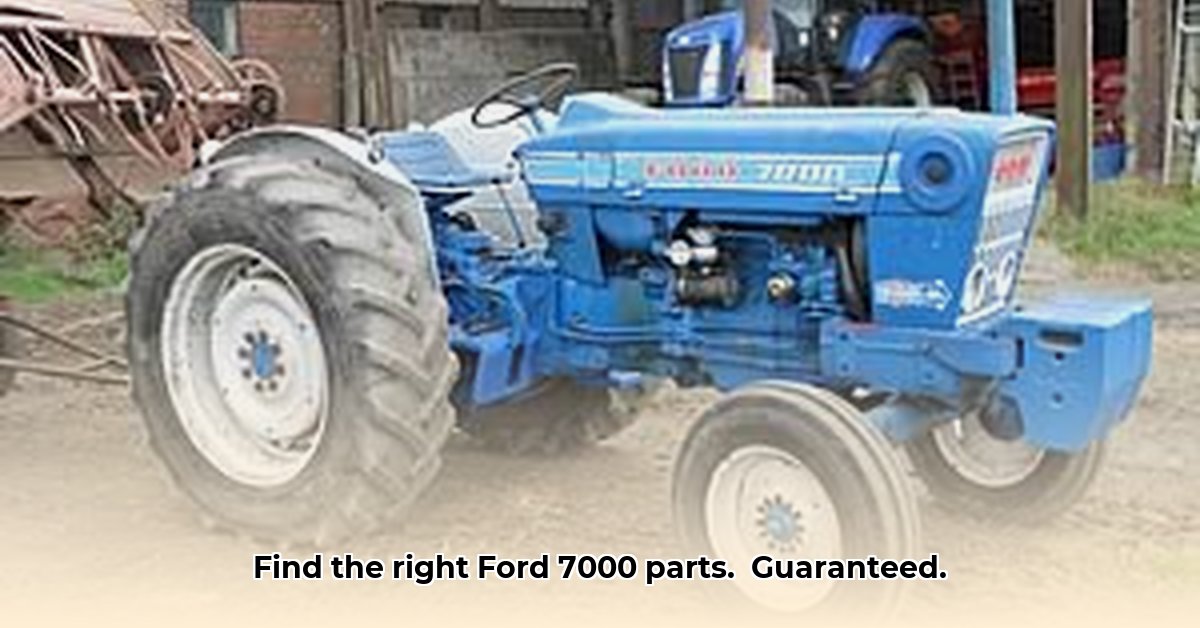
Ford 7000 Tractor Parts: A Comprehensive Sourcing Guide
Keeping your Ford 7000 tractor running smoothly requires access to reliable parts. This guide navigates the complexities of sourcing Ford 7000 components, ensuring you get the right quality at the right price, whether for routine maintenance or a full restoration. We'll explore market dynamics, part types, quality considerations, and sourcing strategies. For even more detailed information, check out this helpful resource.
The Ford 7000 Parts Market: An Overview
The demand for Ford 7000 tractor parts remains strong. These robust machines continue to serve farmers and enthusiasts worldwide, fostering a vibrant market for both new and used/rebuilt components. Major suppliers, specialized dealers, and online marketplaces cater to this demand, offering a wide range of parts, from simple wear items (like filters and belts) to hard-to-find restoration pieces. This robust market presents both opportunities and challenges. Did you know that the availability of certain parts can fluctuate seasonally, sometimes impacting prices?
Understanding Ford 7000 Part Types
The variety of parts available can be overwhelming, but understanding the categories simplifies your search. Key areas include:
- Engine Components: Ranging from simple gaskets and filters to complex parts like pistons and crankshafts, engine components are crucial for performance.
- Transmission Parts: Essential for power transmission, these include gears, bearings, synchronizers, and seals. Malfunctions here can severely impact tractor operation.
- Hydraulic System Parts: This system, responsible for lifting implements and powering attachments, involves pumps, valves, cylinders, and hoses. Leaks or failures can have significant consequences.
- Body Parts: These exterior components, including sheet metal, fenders, and panels, impact both functionality and aesthetics, often crucial for restorations.
Navigating Part Quality: OEM vs. Aftermarket
Part quality significantly impacts your tractor's longevity and performance.
- Original Equipment Manufacturer (OEM) Parts: These Ford-manufactured parts guarantee the best fit, durability, and reliability, although they are typically more expensive. For critical components, OEM parts are the best investment.
- Aftermarket Parts: Produced by companies other than Ford, these offer varying quality and price points. Some aftermarket parts match OEM quality, while others may fall short, potentially leading to premature failure.
Identifying Reputable Suppliers:
- Verify Seller Reputation: Check online reviews and testimonials thoroughly.
- Examine Part Descriptions: Look for precise material specifications and manufacturing details. Vague descriptions should raise concerns.
- Don't Hesitate to Ask Questions: A trustworthy supplier willingly answers your questions about sourcing and quality.
- Be Wary of Extremely Low Prices: Prices too low often indicate counterfeit or inferior goods.
Sourcing Ford 7000 Tractor Parts: A Multi-Platform Approach
Finding parts involves utilizing various resources:
- Online Retailers: Many specialize in tractor parts, offering extensive catalogs and convenient online ordering.
- Specialized Suppliers: These businesses often focus on classic tractors, potentially providing hard-to-find components.
- Online Forums and Classifieds: These communities offer valuable advice and potential leads on used or surplus parts.
- Local Dealers (if available): Check local agricultural equipment dealers, who may still stock parts for older models.
Cost Considerations: Balancing Budget and Value
Prices range widely. New OEM parts are most expensive, while used and rebuilt options offer cost savings but potentially reduced longevity. Weigh the cost against your budget and the overall value of your tractor. Choosing the right parts balances cost and long-term reliability. Is the higher initial cost of an OEM part offset by its longer lifespan and reduced downtime?
Preventative Maintenance: Investing in Longevity
Regular maintenance significantly reduces the risk of costly repairs. Consistent upkeep—including fluid changes, belt and hose checks, and routine inspections—is crucial. Prioritizing quality parts during maintenance directly contributes to your tractor's long-term health and performance. Proper maintenance can increase your tractor's lifespan by as much as 20%!
Conclusion: Informed Decisions for Long-Term Success
Finding the right Ford 7000 parts requires diligent research and careful consideration. By understanding the market, identifying reputable suppliers, and prioritizing preventative maintenance, you ensure your tractor's peak performance for years to come. Remember that investing in quality parts translates to increased reliability and reduced long-term costs. Making smart, informed decisions today will safeguard your investment in your Ford 7000 for years ahead.